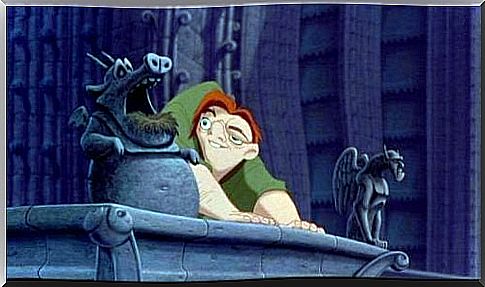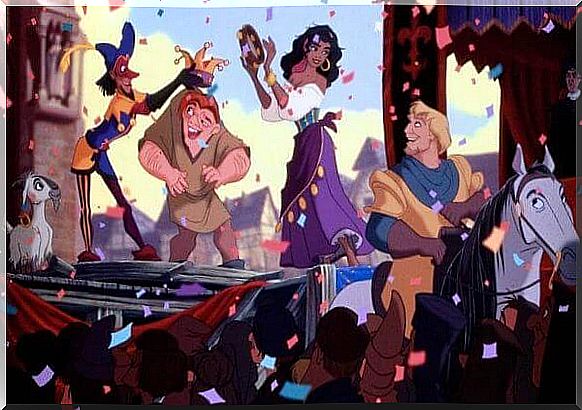The Ringer Of Notre Dame: Disney’s Darkest Story

The Ringer in Notre Dame (1996), despite being a Disney movie, has a dark plot that can be difficult to understand. I do not mean a “dark” happiness like A pre-Christmas nightmare, or the frightening darkness of Taran and the Black Pot, one of Disney’s lesser known films. The darkness of the Ringer in Notre Dame has nothing to do with this. It is different, real and raw. That is probably why many 90s children did not appreciate it at that time.
This is a famous movie that has received good reviews, made a good profit, and had very good publicity. But when it came out, most of us were too young to understand it. That may be why this movie is not among Disney’s top 10 movies of all time.
For this reason, it was not very popular with children. On the contrary, it is as if people forgot it. Although there are many Disney movies that hide a dark plot and an analysis-worthy background, The Ringer in Notre Dame is far from the Disney stereotype. Its history is laden with criticism of society and power, especially concerning the Church.
The Ringer of Notre Dame
This film is based on Our Lady of Paris, a novel by Victor Hugo published in 1831. This was rejected by the author’s followers, since they were expecting a darker novel, faithful to the original. But, as expected, Disney made this gentle (-like) movie so the kids wouldn’t leave the cinema. Despite their efforts to turn this story into a sweet one, it was too vague for many children, which meant that they did not understand it at the time.
There are two other (rawer) adaptations of this short story, also called The Ringer in Notre Dame, filmed in 1939 and 1956. From an adult perspective, we can see that this is a great animated film with fascinating scenarios and a surprising and captivating message.

The ecclesiastical in the Ringer in Notre Dame
The main difference regarding Victor Hugo’s original novel is Judge Frollo. In the original version, Frollo is the rector of Notre Dame, but he is a judge in the Disney version. This is completely understandable, as it is a movie for children.
Although they presented Frollo as a judge, his character is related to the cathedral, he has a strong religious faith and his attire is quite ecclesiastical. This discredited the image of the Church a little.
Frollo should be a lawyer, a respectable and fair character, but he is actually quite the opposite. We see his ruthlessness, his arrogance, and how he despises those who are different from him. Frollo hates gypsies and anyone who is not like him. However, life will mess with him, and he will end up experiencing emotions he never thought he could experience.
Frollo begins to become obsessed with Esmeralda, the gypsy. His feelings for her are not healthy. She becomes a valuable and tempting object, like the “execution of evil.” Suddenly, Frollo gets a sick desire that makes him reconsider his faith. Frollo believes that his desire for Esmeralda is a test from God, and that he must avoid sin. However, his desire becomes so obsessive that he eventually wants her to be his property, otherwise she must die.
Frollo’s obsession will lead to one of Disney’s most disruptive musical moments. A song where religious connotations are obvious from the beginning: church choir, a large cross, Frollo’s costume. Realizing all this as adults makes us believe that Frollo may not only be a judge, but he may be associated with the Church.
The musical moment
This musical moment is important for us to better understand this character. He is a cruel and ruthless judge who imposes his law on the shame of innocent people, and he also hides something else. Frollo is a very disturbing and unpleasant character. His irrational and obsessive desire for Esmeralda is almost more frightening than anything else in the film. Behind his puritanical and correct image lies a man with very dubious morals.
Victor Hugo’s novel is ruthless rather than compassionate. On the other hand, the Ringer in Notre Dame is more sugary and less controversial, making it easier for the general public to digest. Through the character Frollo and the aforementioned musical scene, we get an overview of the original story: a trace of the harsh criticism of the Church and its undeniable power.

What’s different about the Ringer in Notre Dame?
In addition to the criticism of society and the church, the Ringer in Notre Dame also deals with problems such as differences and acceptance. People do not associate kindness with people’s appearance. We have a cruel judge and an innocent, kind-hearted character whose appearance is unpleasant to most people. Society does not accept Quasimodo because of the way he looks. Therefore, he only dares to leave Notre Dame on “the day when everything is backwards”. On this day it is a kind of carnival where people celebrate all strange things.
Quasimodo’s “costume” fascinated the audience. If they knew he actually looked like that, they would all look at him like a monster. Only one character shows compassion for Quasimodo; Esmeralda, the young man marginalized and persecuted the gypsy. Esmeralda is a fighter. She is the only one who dares to meet Frollo and pray for justice and equality for all.
Frollo made Quasimodo feel incredibly insecure, which led him to see himself as a monster. Quasimodo established a kind of friendship with the water throwers in the cathedral. Esmeralda and the water throwers open Quasimodo’s eyes and make him see reality. In addition, Captain Febo, a soldier who turns his back on Frollo, also plays an important role, joining the fight for equality.
Who is the real monster in Notre Dame? The film shows its true nature, a camouflaged monster that walks among us day by day and enjoys the respect of society. The Ringer of Notre Dame is a movie we must save. In short, the plot is more complicated and darker than the typical children’s films, but it is also full of fantastic values, and speaks for justice and equality.







